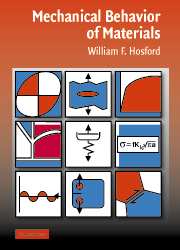Book contents
- Frontmatter
- Contents
- Preface
- Note to the Reader
- 1 Stress and Strain
- 2 Elasticity
- 3 Tensile Testing
- 4 Other Tests of Plastic Behavior
- 5 Strain-Hardening of Metals
- 6 Plasticity Theory
- 7 Strain-Rate and Temperature Dependence of Flow Stress
- 8 Slip
- 9 Dislocation Geometry and Energy
- 10 Dislocation Mechanics
- 11 Mechanical Twinning and Martensitic Shear
- 12 Hardening Mechanisms in Metals
- 13 Ductility and Fracture
- 14 Fracture Mechanics
- 15 Viscoelasticity
- 16 Creep and Stress Rupture
- 17 Fatigue
- 18 Residual Stresses
- 19 Ceramics and Glasses
- 20 Polymers
- 21 Composites
- 22 Mechanical Working
- Appendix A Miller Indices
- Appendix B Stereographic Representation of Orientations
- Index
3 - Tensile Testing
Published online by Cambridge University Press: 05 June 2012
- Frontmatter
- Contents
- Preface
- Note to the Reader
- 1 Stress and Strain
- 2 Elasticity
- 3 Tensile Testing
- 4 Other Tests of Plastic Behavior
- 5 Strain-Hardening of Metals
- 6 Plasticity Theory
- 7 Strain-Rate and Temperature Dependence of Flow Stress
- 8 Slip
- 9 Dislocation Geometry and Energy
- 10 Dislocation Mechanics
- 11 Mechanical Twinning and Martensitic Shear
- 12 Hardening Mechanisms in Metals
- 13 Ductility and Fracture
- 14 Fracture Mechanics
- 15 Viscoelasticity
- 16 Creep and Stress Rupture
- 17 Fatigue
- 18 Residual Stresses
- 19 Ceramics and Glasses
- 20 Polymers
- 21 Composites
- 22 Mechanical Working
- Appendix A Miller Indices
- Appendix B Stereographic Representation of Orientations
- Index
Summary
Introduction
Tensile test data have many uses. Tensile properties are used in selecting materials for various applications. Material specifications often include minimum tensile properties to ensure quality. Tests must be made to ensure that materials meet these specifications. Tensile properties are also used in research and development to compare new materials or processes. With plasticity theory, tensile stress–strain curves can be used to predict a material's behavior under forms of loading other than uniaxial tension.
Often the primary concern is strength. The level of stress that causes appreciable plastic deformation of a material is called its yield stress. The maximum tensile stress that a material carries is called its tensile strength (or ultimate strength or ultimate tensile strength). Both of these measures are used, with appropriate caution, in engineering design. A material's ductility is also of interest. Ductility is a measure of how much the material can deform before it fractures. Rarely, if ever, is the ductility incorporated directly into design. Rather it is included in specifications to ensure quality and toughness. Elastic properties may be of interest, but these are measured ultrasonically much more accurately that by tension testing.
Tensile specimens
Figure 3.1 shows a typical tensile specimen. It has enlarged ends or shoulders for gripping. The important part of the specimen is the gauge section. The cross-sectional area of the gauge section is less than that of the shoulders and grip region, so the deformation will occur here.
- Type
- Chapter
- Information
- Mechanical Behavior of Materials , pp. 39 - 52Publisher: Cambridge University PressPrint publication year: 2005
- 2
- Cited by



